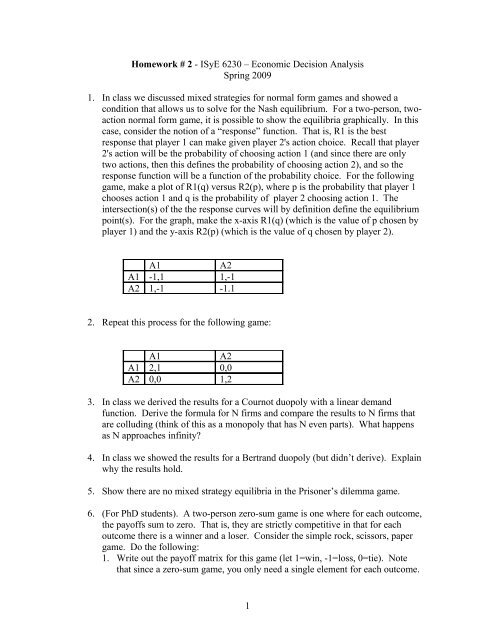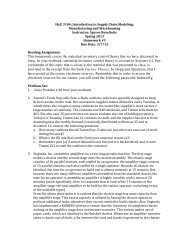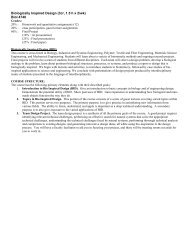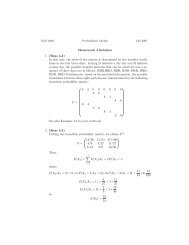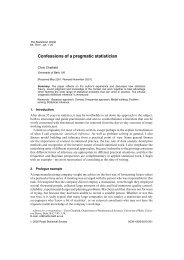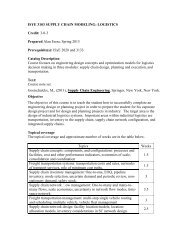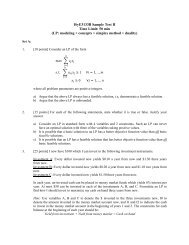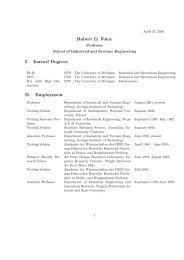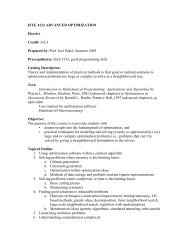Homework # 2 - ISyE 6230 – Economic Decision Analysis Spring ...
Homework # 2 - ISyE 6230 – Economic Decision Analysis Spring ...
Homework # 2 - ISyE 6230 – Economic Decision Analysis Spring ...
Create successful ePaper yourself
Turn your PDF publications into a flip-book with our unique Google optimized e-Paper software.
<strong>Homework</strong> # 2 - <strong>ISyE</strong> <strong>6230</strong> <strong>–</strong> <strong>Economic</strong> <strong>Decision</strong> <strong>Analysis</strong><br />
<strong>Spring</strong> 2009<br />
1. In class we discussed mixed strategies for normal form games and showed a<br />
condition that allows us to solve for the Nash equilibrium. For a two-person, twoaction<br />
normal form game, it is possible to show the equilibria graphically. In this<br />
case, consider the notion of a “response” function. That is, R1 is the best<br />
response that player 1 can make given player 2's action choice. Recall that player<br />
2's action will be the probability of choosing action 1 (and since there are only<br />
two actions, then this defines the probability of choosing action 2), and so the<br />
response function will be a function of the probability choice. For the following<br />
game, make a plot of R1(q) versus R2(p), where p is the probability that player 1<br />
chooses action 1 and q is the probability of player 2 choosing action 1. The<br />
intersection(s) of the the response curves will by definition define the equilibrium<br />
point(s). For the graph, make the x-axis R1(q) (which is the value of p chosen by<br />
player 1) and the y-axis R2(p) (which is the value of q chosen by player 2).<br />
A1<br />
A2<br />
A1 -1,1 1,-1<br />
A2 1,-1 -1.1<br />
2. Repeat this process for the following game:<br />
A1<br />
A2<br />
A1 2,1 0,0<br />
A2 0,0 1,2<br />
3. In class we derived the results for a Cournot duopoly with a linear demand<br />
function. Derive the formula for N firms and compare the results to N firms that<br />
are colluding (think of this as a monopoly that has N even parts). What happens<br />
as N approaches infinity?<br />
4. In class we showed the results for a Bertrand duopoly (but didn’t derive). Explain<br />
why the results hold.<br />
5. Show there are no mixed strategy equilibria in the Prisoner’s dilemma game.<br />
6. (For PhD students). A two-person zero-sum game is one where for each outcome,<br />
the payoffs sum to zero. That is, they are strictly competitive in that for each<br />
outcome there is a winner and a loser. Consider the simple rock, scissors, paper<br />
game. Do the following:<br />
1. Write out the payoff matrix for this game (let 1=win, -1=loss, 0=tie). Note<br />
that since a zero-sum game, you only need a single element for each outcome.<br />
1
2. Write a linear program to find the optimal strategy for each player.<br />
3. Comment on the result.<br />
2


